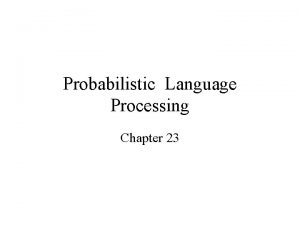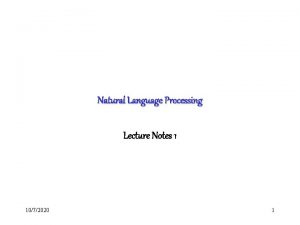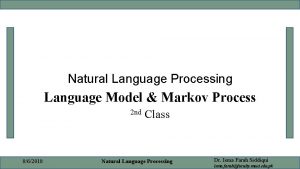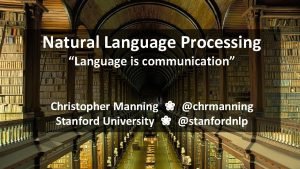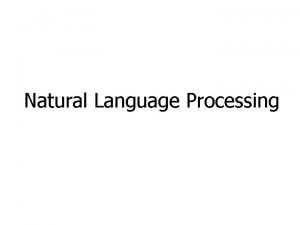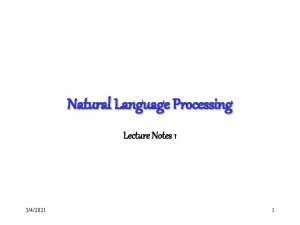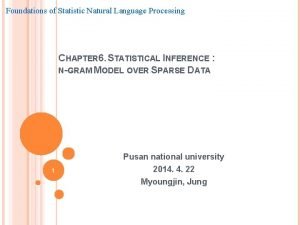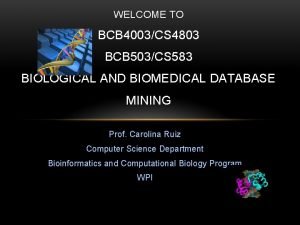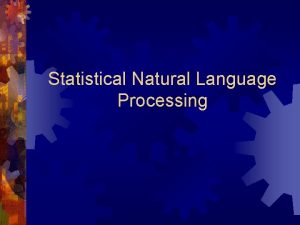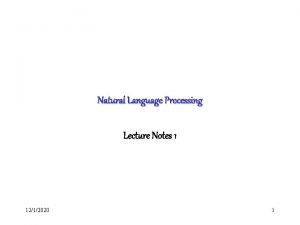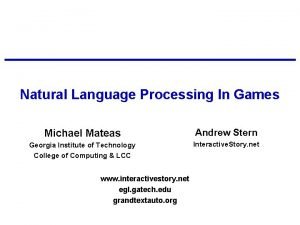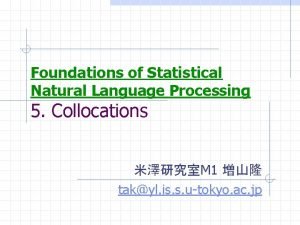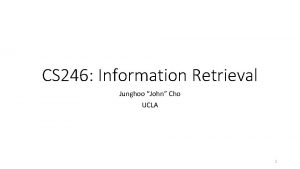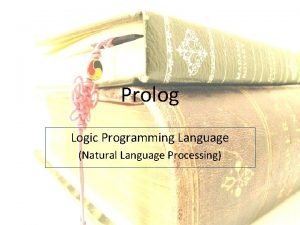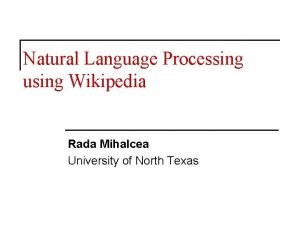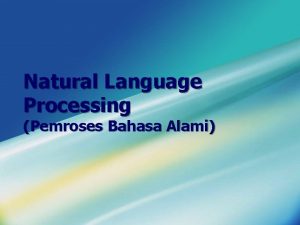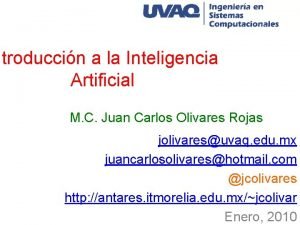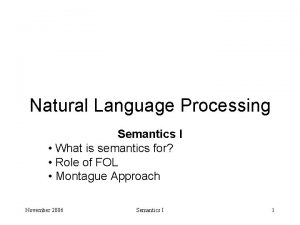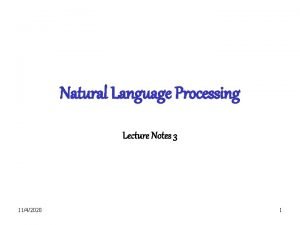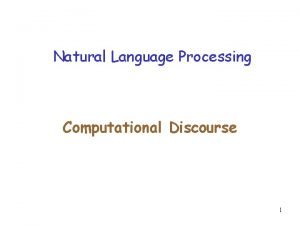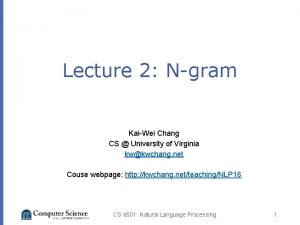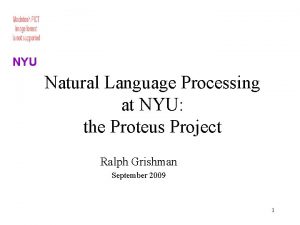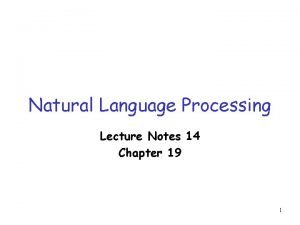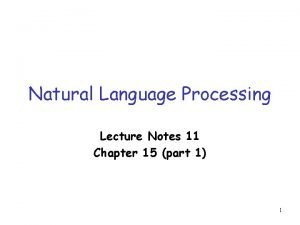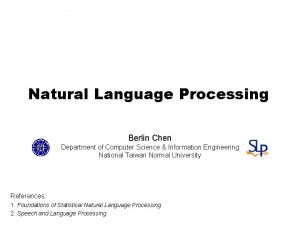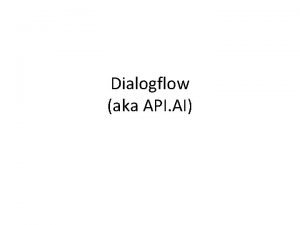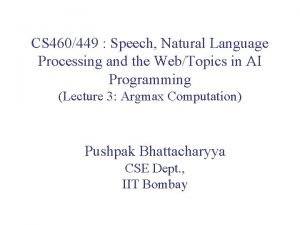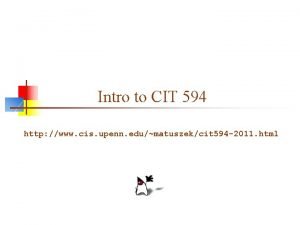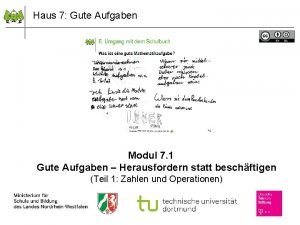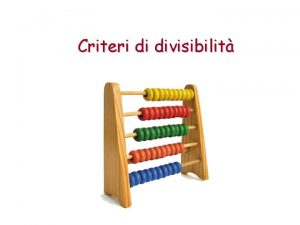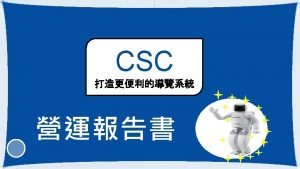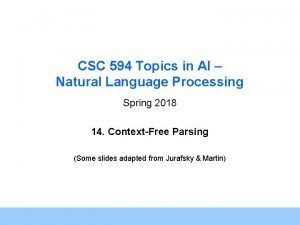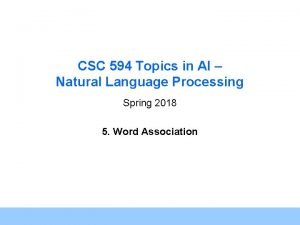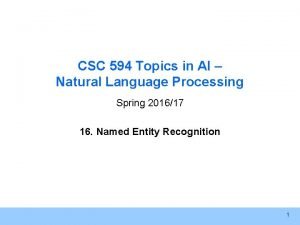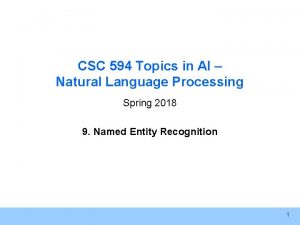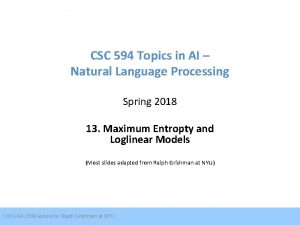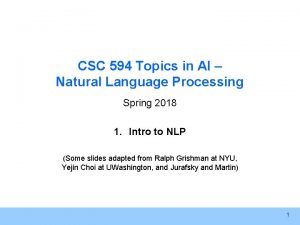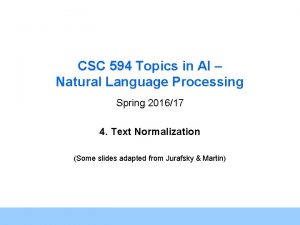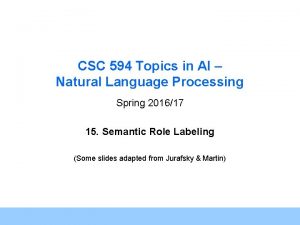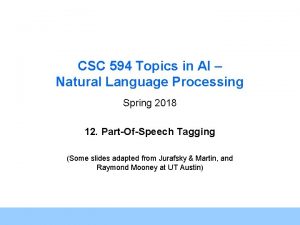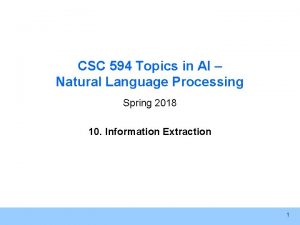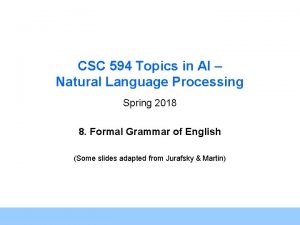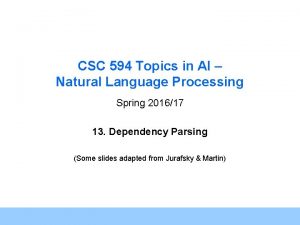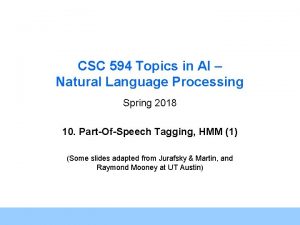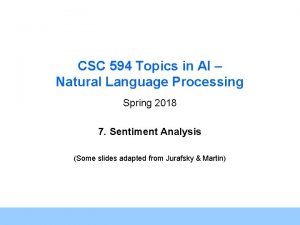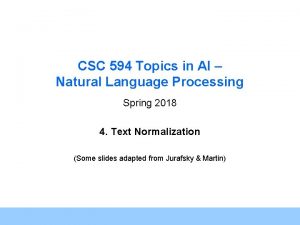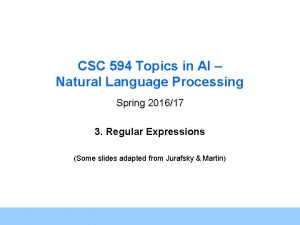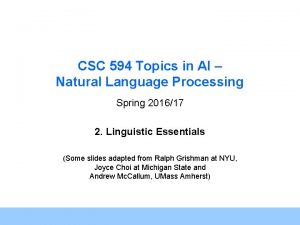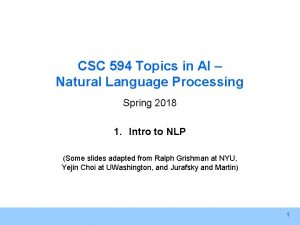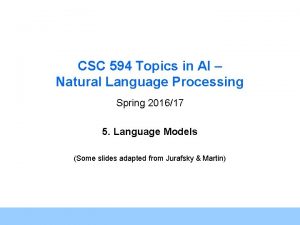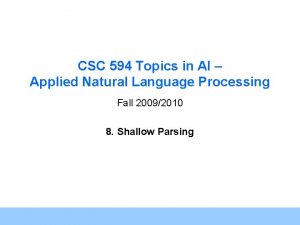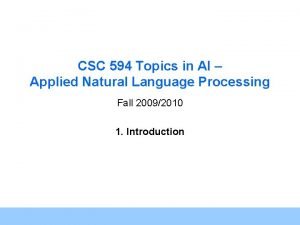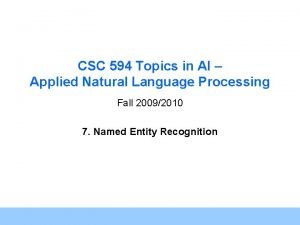CSC 594 Topics in AI Natural Language Processing


































- Slides: 34

CSC 594 Topics in AI – Natural Language Processing Spring 2016/17 17. Information Extraction 1

Information Extraction (IE) • • • Identify specific pieces of information (data) in an unstructured or semi-structured text Transform unstructured information in a corpus of texts or web pages into a structured database (or templates) Applied to various types of text, e. g. – Newspaper articles – Scientific articles – Web pages – etc. Source: J. Choi, CSE 842, MSU 2

Bridgestone Sports Co. said Friday it had set up a joint venture in Taiwan with a local concern and a Japanese trading house to produce golf clubs to be supplied to Japan. The joint venture, Bridgestone Sports Taiwan Co. , capitalized at 20 million new Taiwan dollars, will start production in January 1990 with production of 20, 000 iron and “metal wood” clubs a month. template filling TIE-UP-1 Relationship: TIE-UP Entities: “Bridgestone Sport Co. ” “a local concern” “a Japanese trading house” Joint Venture Company: “Bridgestone Sports Taiwan Co. ” Activity: ACTIVITY-1 Amount: NT$20000 ACTIVITY-1 Activity: PRODUCTION Company: “Bridgestone Sports Taiwan Co. ” Product: “iron and ‘metal wood’ clubs” Start Date: DURING: January 1990 3

Why Information Extraction (IE)? • Science – Grand old dream of AI: Build large knowledge base (KB) and reason with it. IE enables the automatic creation of this KB. – IE is a complex problem that inspires new advances in machine learning. • Profit – Many companies interested in leveraging data currently “locked in unstructured text on the Web”. – Not yet a monopolistic winner in this space. • Fun! – Build tools that we researchers like to use ourselves: Cora & Cite. Seer, MRQE. com, FAQFinder, … – See our work get used by the general public. Source: Andrew Mc. Callum, UMass Amherst 4

A Typical IE Processing Pipeline Named Entity Recognition (NER) & Shallow Parsing Reference Resolution Relation Detection & Classification Event Detection & Classification Template Filling 5

1. Named Entity Recognition IOB notation Word IE by statistical sequence labeling approach POS Chunk Entity. Type 6

1. Named Entity Recognition (cont. ) • After NEs are identified, dependency parsing is often applied to extract the syntactic/dependency relations between the NEs. [PER Bill Gates] founded [ORG Microsoft]. found nsubj Bill Gates dobj Dependency Relations nsubj(Bill Gates, found) dobj(found, Microsoft) Microsoft 7

2. Reference Resolution • Two types of references: – Anaphora resolution • Identify what a pronoun refers to (an entity that appeared earlier in the text) – “he”, “she”, “it”, “they” – Co-reference resolution • Identify what a noun (or noun phrase) refers to Queen Elizabeth set about transforming her husband, King George VI, into a viable monarch. Logue, a renowned speech therapist, was summoned to help the King overcome his speech impediment. . . • Reference resolution is an important step in IE and a very difficult problem in NLP. However, we don’t cover it in this class. 8

3. Relation Detection • Identify the semantic relations between named entities (or domain elements) • Relations include: – General relations such as “part-of” and “employs” – Domain-specific relations Semantic relations with examples and the NE types they involve Source: Jurafsky & Martin “Speech and Language Processing” 9

3. 1 Supervised Learning for Relation Analysis • Training data: – Use a corpus annotated with NEs and relations – An instance indicates two arguments, their roles, and the type of the relation involved Source: Jurafsky & Martin “Speech and Language Processing” 10

Supervised Learning for Relation Analysis (cont. ) • Typical approach: – Step 1: Detect if a relation exists between two entities – Step 2: If so, classify/label the relation • Features to represent an instance: Source: Jurafsky & Martin “Speech and Language Processing” 11

3. 2 Pattern-based Relation Analysis • When an annotated corpus is not available, lightlysupervised methods can be used – Step 1: Define a set of seed patterns as regular expressions, and extract all tuples that match the patterns – Step 2: Bootstrap to find new patterns 12

4. Event Detection • Identify events or states mentioned for named entities (or domain elements) [event Citing] high fuel prices, United Airlines [event said] Friday it has [event increased] fares by $6 per round trip on flights to some cities also served by lower-cost carriers. • In English, events correspond to verbs, plus some noun phrases (e. g. “the increase”, “the destruction”) – But some difficult cases, e. g. • Not all verbs denote an event (e. g. “took effect”) • ‘Light verbs’ such as “make”, “take” are too generic. Must also look at its direct object/noun (e. g. “took a flight”) • Of course, always the problem of (meaning) ambiguity… Source: Jurafsky & Martin “Speech and Language Processing” 13

Event Detection (cont. ) • Both rule-based and statistical ML approaches have been used for event detection • Features to represent an event instance: Source: Jurafsky & Martin “Speech and Language Processing” 14

5. Template Filling • A template is a frame (of a record structure), consisting of slots and fillers. A template denotes an event or a semantic concept. • After extracting NEs, relations and events, IE fills an appropriate template • Two common approaches for template filling: – Statistical approach – Finite-state cascade approach Source: Jurafsky & Martin “Speech and Language Processing” 15

5. 1 Statistical Approach to Template Filling • Again, by using a sequence labeling method: – Label sequences of tokens as potential fillers for a particular slot – Train separate sequence classifiers for each slot – Slots are filled with the text segments identified by each slot’s corresponding classifier – Resolve multiple labels assigned to the same/overlapping text segment by adding weights (heuristic confidence) to the slots – State-of-the-art performance – F 1 -measure of 75 to 98 • However, those methods are shown to be effective only for small, homogenous data. Source: Jurafsky & Martin “Speech and Language Processing” 16

5. 2 Finite-State Template-Filling Systems • Message Understanding Conferences (MUC) – the genesis of IE – DARPA funded significant efforts in IE in the early to mid 1990’s. – MUC was an annual event/competition where results were presented. – Focused on extracting information from news articles: • Terrorist events (MUC-4, 1992) • Industrial joint ventures (MUC-5, 1993) • Company management changes – Information extraction of particular interest to the intelligence community (CIA, NSA). (Note: early ’ 90’s) Source: Marti Hearst, i 256, at UC Berkeley 17

Finite-State Template-Filling Systems (cont. ) • FASTUS system in MUC-5 – A cascade of transducers, where each level is a finite-state automata which extracts a specific type of information – The task was to fill hierarchically linked templates Source: Marti Hearst, i 256, at UC Berkeley 18

Example of IE from FASTUS (1993) Bridgestone Sports Co. said Friday it had set up a joint venture in Taiwan with a local concern and a Japanese trading house to produce golf clubs to be supplied to Japan. The joint venture, Bridgestone Sports Taiwan Co. , capitalized at 20 million new Taiwan dollars, will start production in January 1990 with production of 20, 000 iron and “metal wood” clubs a month. TIE-UP-1 Relationship: TIE-UP Entities: “Bridgestone Sport Co. ” “a local concern” “a Japanese trading house” Joint Venture Company: “Bridgestone Sports Taiwan Co. ” Activity: ACTIVITY-1 Amount: NT$20000 Source: Marti Hearst, i 256, at UC Berkeley ACTIVITY-1 Activity: PRODUCTION Company: “Bridgestone Sports Taiwan Co. ” Product: “iron and ‘metal wood’ clubs” Start Date: DURING: January 1990 19

Evaluating IE Accuracy • Precision and Recall: – Precision: correct answers / answers produced – Recall: correct answers / total possible correct answers • F-measure: where β is a parameter representing relative importance of P and R. When P and R are equally important, β = 1 and we get the F 1 measure: Source: J. Choi, CSE 842, MSU 20

MUC Information Extraction: State of the Art c. 1997 NE – named entity recognition CO – co-reference resolution TE – template element construction TR – template relation construction ST – scenario template production Source: Marti Hearst, i 256, at UC Berkeley 21

Successors to MUC • Co. NLL: Conference on Computational Natural Language Learning – – – Different topics each year 2002, 2003: Language-independent NER 2004: Semantic Role recognition 2001: Identify clauses in text 2000: Chunking boundaries • http: //cnts. uia. ac. be/conll 2003/ (also conll 2004, conll 2002…) • Sponsored by SIGNLL, the Special Interest Group on Natural Language Learning of the Association for Computational Linguistics. • ACE: Automated Content Extraction – Entity Detection and Tracking • Sponsored by NIST • http: //wave. ldc. upenn. edu/Projects/ACE/ • Several others recently – See http: //cnts. uia. ac. be/conll 2003/ner/ Source: Marti Hearst, i 256, at UC Berkeley 22

State of the Art Performance: examples • Named entity recognition from newswire text – Person, Location, Organization, … – F 1 in high 80’s or low- to mid-90’s • Binary relation extraction – Contained-in (Location 1, Location 2) Member-of (Person 1, Organization 1) – F 1 in 60’s or 70’s or 80’s • Web site structure recognition – Extremely accurate performance obtainable – Human effort (~10 min? ) required on each site Source: Marti Hearst, i 256, at UC Berkeley 23

Advanced Topic: Biomedical Information Extraction • IE from biomedical journal articles has become an important application area lately – due to a rapid growth in the number of publications in the field. Source: Jurafsky & Martin “Speech and Language Processing” 24

Biological NER • There a much wider range of entity types (semantic classes) in the biological domain [tissue Plasma] [GP BNP] concentrations were higher in both the [population judo] and [population marathon groups] than in [population controls], and positively correlated with [ANAT LV] mass as well as with deceleration time. Source: Jurafsky & Martin “Speech and Language Processing” 25

Biological NER (cont. ) • NER in this domain is particularly difficult because of the various forms which the names can take: – – e. g. “insulin”, “ether a go-go”, “breast cancer associated 1” Long names (thus multi-token boundary detection is needed) Spelling/typographical variations Abbreviations, symbols (Of course) Ambiguity (common meaning or domain concepts) • Extracted NEs are often mapped to biomedical ontologies (e. g. Gene Ontology, UMLS) Source: Jurafsky & Martin “Speech and Language Processing” 26

Biological Roles and Relations • Two approaches: – Discover and classify binary relations between NEs (1) These results suggest that con A-induced [disease hepatitis] was ameliorated by pretreatment with [treatment TJ-135]. ‘curing’ relation (2) [disease Malignant mesodermal mixed tumor of the uterus] following [treatment irradiation] ‘result’ relation – Identify and classify the roles played by NEs w. r. t. the event --which constituents for which semantic roles [theme Full-length c. PLA 2] was [target phosphorylated] stoichiometrically by [agent p 43 mitrogen-activated protein (MAP) kinase] into vitro … and the major site of phosphorylation was identified by amino acid sequencing as [site Ser 505]. Note: the event for this sentence is ‘PHOSPHORYLATION’ Source: Jurafsky & Martin “Speech and Language Processing” 27

Automatic Role Labeling for Biological Domain • Both rule-based and statistical approaches have been applied • Medical ontologies (in particular the link/inference structures) are often utilized • General results: The choice of algorithm is less important than the choice of features • Note: NER methods utilize syntactic features -- but no large treebanks are available for biomedical domain Off-the-shelf NER tools (trained with generic newswire exts) are often used. Source: Jurafsky & Martin “Speech and Language Processing” 28

IE Techniques: Summary • Machine learning approaches are doing well, even without comprehensive word lists – Can develop a pretty good starting list with a bit of web page scraping – Lately Conditional Random Fields (CRFs) have shown superb performance over other sequence-labeling ML techniques • Features mainly have to do with the preceding and following tags, as well as syntax and orthographic features of words – The latter is somewhat language dependent • With enough training data, results are getting pretty decent on well-defined entities • ML is the way of the future! Source: Marti Hearst, i 256, at UC Berkeley 29

Extra: From Text to Actionable Knowledge Source: Andrew Mc. Callum, UMass Amherst 30

Source: Andrew Mc. Callum, UMass Amherst 31

Source: Andrew Mc. Callum, UMass Amherst 32

Source: Andrew Mc. Callum, UMass Amherst 33

Research Questions • What model structures will capture salient dependencies? • Will joint inference actually improve accuracy? • How to do inference in these large graphical models? • How to do parameter estimation efficiently in these models, which are built from multiple large components? • How to do structure discovery in these models? Source: Andrew Mc. Callum, UMass Amherst 34
 Natural language processing vietnamese
Natural language processing vietnamese Probabilistic model natural language processing
Probabilistic model natural language processing Natural language processing
Natural language processing Markov chain natural language processing
Markov chain natural language processing Manning natural language processing
Manning natural language processing Language
Language Natural language processing
Natural language processing Natural language processing lecture notes
Natural language processing lecture notes Language
Language Natural language processing fields
Natural language processing fields Natural language processing fields
Natural language processing fields Natural language processing lecture notes
Natural language processing lecture notes Natural language processing games
Natural language processing games Foundations of statistical natural language processing
Foundations of statistical natural language processing Ucla natural language processing
Ucla natural language processing Prolog natural language processing
Prolog natural language processing Natural language processing wikipedia
Natural language processing wikipedia Pengertian natural language
Pengertian natural language Natural language processing
Natural language processing Language synonyms
Language synonyms Natural language processing
Natural language processing Machine translation in natural language processing
Machine translation in natural language processing Natural language processing lecture notes
Natural language processing lecture notes Natural language processing
Natural language processing Natural language processing
Natural language processing Adam meyers nyu
Adam meyers nyu Natural language processing lecture notes
Natural language processing lecture notes Natural language processing lecture notes
Natural language processing lecture notes Natural language processing berlin
Natural language processing berlin Dialogflow natural language processing
Dialogflow natural language processing Natural language processing
Natural language processing Cit upenn
Cit upenn Pikas haus 7
Pikas haus 7 Numeri divisibili per 9
Numeri divisibili per 9 Cit594
Cit594

